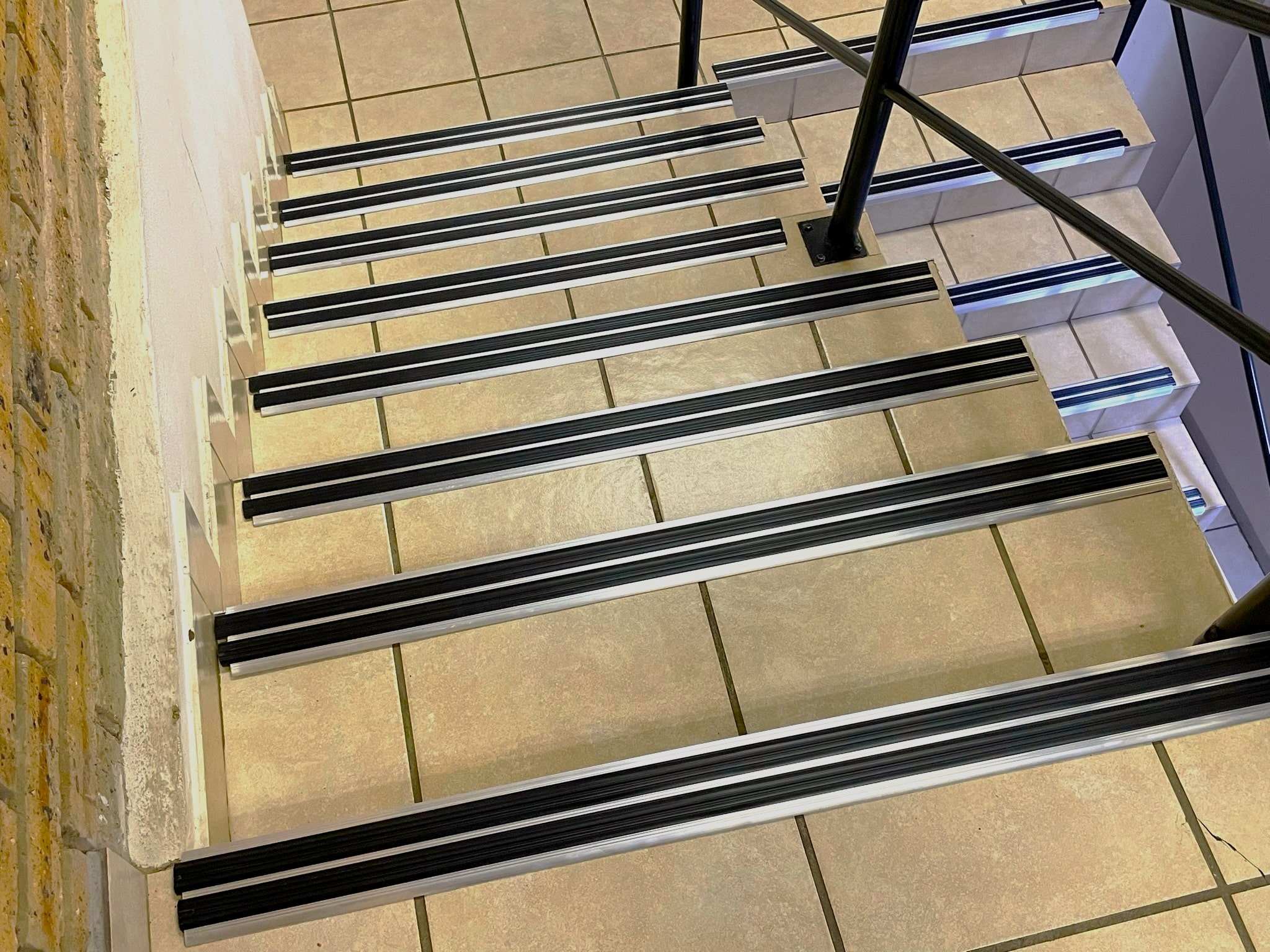Are your stairs looking worn out and in need of some protection? If so, then stair-nosing is the solution you’ve been looking for. Stair nosing is an essential investment for safeguarding your stairs and enhancing their longevity.
Stair nosing is a protective edge added to a step’s front edge. It acts as a barrier, preventing excessive wear and tear caused by regular use and foot traffic. With stair nosing, you can protect your stairs from scrapes, scratches, and chips that can occur over time.
Investing in stair nosing not only extends the lifespan of your stairs but also enhances safety. The added grip of the nosing provides extra stability, reducing the risk of slips and falls, especially on slippery surfaces.
Whether you have a residential or commercial property, stair nosing is a worthy investment that offers both practical and aesthetic benefits. It protects your stairs and adds a stylish touch to your interior decor.
Don’t neglect the well-being and appearance of your stairs. Invest in stair nosing today and enjoy the peace of mind of knowing your stairs are protected.
Importance of protecting your stairs
Stairs are essential to any building, providing access to different levels and rooms. However, they are also prone to wear and tear due to regular use and foot traffic. Over time, the constant impact of footsteps can cause scrapes, scratches, and chips on the edges of the stairs. This affects the appearance of your stairs and poses a safety hazard.
Common stair-related accidents and injuries
Stairs can be dangerous, especially when they are not properly protected. According to statistics, stair-related accidents account for many injuries each year. Slippery surfaces, uneven steps, and lack of handrails are common causes of these accidents. Without the appropriate protection, the edges of the stairs can become worn down, making them even more hazardous.
What is stair nosing, and how does it work?
Stair nosing is a protective edge added to a step’s front edge. It acts as a barrier, preventing excessive wear and tear caused by regular use and foot traffic. The nosing is made from durable materials such as aluminum, rubber, or PVC, designed to withstand the impact of footsteps and protect the edges of the stairs.
Stair nosing is typically installed on the edge of each step, providing an additional layer of protection. The nosing extends slightly beyond the edge of the step, creating a rounded or squared-off profile that reduces the risk of trips and falls. It also adds grip to the step, providing extra stability and reducing the chance of slips, especially on slippery surfaces.
Benefits of installing stair nosing
Investing in stair nosing offers numerous benefits for both residential and commercial properties. Firstly, it extends the lifespan of your stairs by protecting them from scrapes, scratches, and chips. By preventing these damages, you can avoid costly repairs or replacements.
Secondly, stair nosing enhances safety by reducing the risk of slips and falls. The added grip and stability the nosing provides make it easier to navigate the stairs, even in wet or slippery conditions. This is especially crucial in commercial settings where high foot traffic is expected.
Moreover, stair nosing adds a stylish touch to your interior decor. With a wide range of materials, colors, and designs, you can choose a nosing that complements your existing aesthetic. This not only protects your stairs but also enhances the overall appearance of your space.
Different types of stair-nosing materials and designs
When choosing stair nosing, there are various materials and designs to consider. Each option offers distinct advantages and suits different environments.
1. Aluminum nosing: Aluminum nosing is popular due to its durability and versatility. It is resistant to corrosion, making it suitable for indoor and outdoor use. Aluminum nosing is available in various finishes, such as anodized or powder-coated, allowing you to match it with your interior or exterior decor.
2. Rubber nosing: Rubber nosing is ideal for areas that require slip resistance, such as high-traffic commercial buildings or outdoor staircases. It provides excellent traction and is resistant to wear and tear. Rubber nosing is available in different colors and profiles, allowing you to choose the one that best suits your needs.
3. PVC nosing: PVC nosing is a cost-effective option that offers durability and easy maintenance. It is resistant to moisture and chemicals, making it suitable for areas with high humidity or exposure to cleaning agents. PVC nosing is available in various colors and designs, allowing you to customize the look of your stairs.
4. Wood nosing: Wood nosing is famous for residential properties, as it adds a warm and natural touch to the stairs. It is available in different wood species and finishes, allowing you to match it with your existing flooring or decor. Wood nosing requires regular maintenance to protect it from moisture and wear.
Factors to consider when choosing stair-nosing
When choosing stair nosing, several factors must be considered to ensure you make a suitable investment.
1. Durability: The chosen nosing material should withstand regular use and foot traffic without deteriorating or losing its protective properties.
2. Grip and slip resistance: The nosing should provide sufficient grip to prevent slips and falls. Look for options with textured surfaces or anti-slip properties.
3. Aesthetic appeal: Consider the design and color of the nosing to ensure it complements your interior or exterior decor. Choose a style that enhances the overall aesthetic of your space.
4. Ease of installation: Some nosing options require professional installation, while others can be easily installed as a DIY project. Consider your level of expertise and the complexity of the installation process.
5. Maintenance requirements: Different materials have varying maintenance needs. Consider the time and effort required to keep the nosing in good condition.
Installation process for stair nosing
The installation process for stair nosing depends on the chosen material and design. It is recommended to hire a professional for a seamless and secure installation. However, if you have experience with DIY projects, you can install some types of nosing yourself.
1. Measure and cut the nosing to the desired length.
2. Clean and prepare the surface of the stairs, ensuring it is free from debris and dust.
3. Apply adhesive or use screws/nails to secure the nosing to the edge of each step, following the manufacturer’s instructions.
4. Allow the adhesive to dry or ensure the screws/nails are securely fastened.
5. Clean up any excess adhesive or debris, leaving a clean and finished look.
Maintenance and care for stair nosing
Regular maintenance and care are essential to ensure the longevity and effectiveness of your stair nosing.
1. Clean the nosing regularly using a mild detergent and water. Avoid using abrasive cleaners that can damage the surface.
2. Remove any dirt, debris, or spills promptly to prevent staining or slipping hazards.
3. Inspect the nosing periodically for any signs of damage or wear. Replace any damaged or worn-out nosing to maintain its protective properties.
4. Check the adhesive or fasteners regularly to ensure they are secure. Tighten or replace them as needed.
Conclusion: The value of investing in stair nosing for long-term stair protection
Investing in stair nosing is a wise decision for protecting and enhancing the lifespan of your stairs. Not only does it shield your stairs from wear and tear, but it also improves safety by reducing the risk of slips and falls. With a wide range of materials, designs, and colors available, you can choose a nosing that suits your needs and complements your interior or exterior decor. Ensure proper installation and regular maintenance to enjoy the long-term benefits of stair nosing. Don’t neglect the well-being and appearance of your stairs. Invest in stair nosing today and enjoy the peace of mind of knowing your stairs are protected.
Types of slip prevention products
Four main categories of injury prevention products increase the safety of your floors. When selecting slip-prevention products, always ask a specialist who can guide you. There are different types of slippery floors.
Anti-Slip Treatments: These products are the best defense against slippery tiles. They are a sure way to increase the safety of your tiles. Used indoors and outdoors, they last for years. An important note is that they only work on unsealed tiles.
Non-Slip Coatings: Perfect for high-traffic and low-traffic areas. Always choose the right product for your use.
Anti-Slip Tape: A versatile product that is used on stairs and ramps. Anti-slip tape is excellent indoors and outdoors and works on many different surfaces.
Cleaning and Maintenance Products: These products should be of the highest quality. Be sure to check the cleaning recommendations of the floor safety products that you have installed.
About Slip No More
With more than 15 years of experience in the slip-prevention industry, our products solve the problem of slippery floors in all areas. Specializing in floor safety, the company has become synonymous with reliable solutions for preventing slips and falls.
Slip No More offers various anti-slip products designed for different surfaces.
As part of our global expansion strategy, we actively engage with our audience on various social media platforms. Slip No More maintains a strong presence on platforms like Facebook, Instagram, Twitter, Linked In, and YouTube. We love connecting with customers and sharing valuable insights on safety measures. This strategic use of social media fosters brand awareness and allows us to interact directly with our diverse customer base.
If you found this article helpful, take a look at our related articles:

